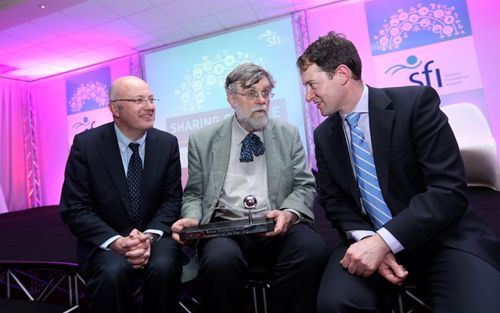Trinity Scientist Named SFI Researcher of the Year 2012
Posted on: 21 November 2012
Two Wins for CRANN at SFI Summit 2012
Trinity’s Professor Michael Coey, one of Ireland’s leading scientists and a SFI- funded researcher was announced as Science Foundation Ireland Researcher of the Year 2012.
Based in the School of Physics and CRANN, Trinity College Dublin’s nanoscience institute, Professor Coey’s career in science has been marked by remarkable scientific discoveries. In addition to this Rohit Mishra, School of Physics and CRANN, won the SFI Image of the Year competition for his image Asteroid Belt.

Prof Mark Ferguson, Director General, SFI, Prof Mike Coey, School of Physics, CRANN and SFI Researcher of the Year with Minister Sean Sherlock
Making the announcement at the recent two day SFI Science Summit, Minister for Research and Innovation, Sean Sherlock TD said: “During his extensive career, Michael has contributed to the continued development of Ireland as a centre of excellence for research by translating scientific excellence into societal and economic impact. As the most cited physical scientist in Ireland, he has made important discoveries such as a new iron-based rare earth magnets, while also educating future generations through his textbooks on magnetism and magnetic materials. I would like to congratulate Michael on his invaluable contribution to research in Ireland, and his significant achievement in being awarded SFI Researcher of the Year 2012.”
Professor Mark Ferguson, Director General of SFI, commented: “The SFI Science Summit offers us the opportunity each year to bring together the best minds in research and innovation and discuss the future of science in Ireland. Importantly, it also provides us with a platform to recognise the outstanding achievements and commitment of those within the science and research community in Ireland and I would like to take this opportunity to congratulate Professor Coey on his prestigious award.”

Rohit Mishra’s winning SFI Image of the Year shows crystallized Carbamide dyed with azo orange. Carbamide (commonly known as Urea) is a strong agent for the unwinding of the DNA double helix and also for denaturing of proteins. It is critical component in diagnostic nanobio devices and sensors. The colours seen in the image are real and are obtained because of the crystal structures interaction with polarized light, the same physical principle used in modern 3D cinema glasses.
